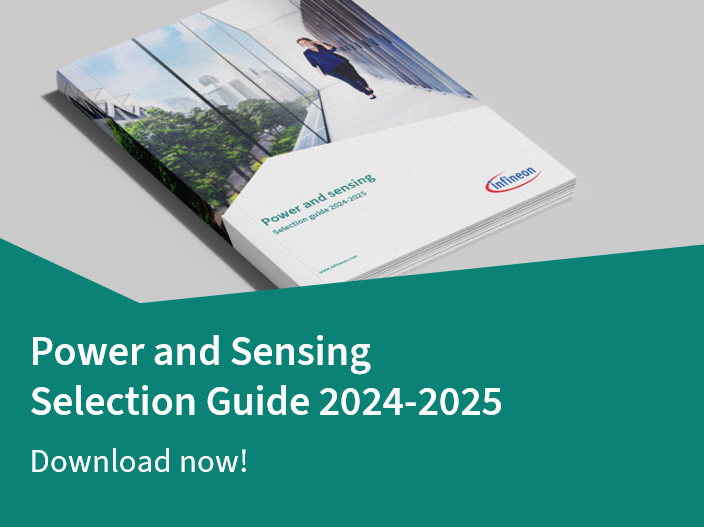Switching regulators
Highly efficient, cost-optimized switching voltage regulators from Infineon
Switching regulators subcategories
Highly efficient and reliable DC-DC switching regulators
A switching regulator power supply is a highly efficient DC-DC converter that can convert an input direct current into an output direct current of a different voltage if required. Switching regulators have low quiescent currents (or standby currents), meaning, they don't consume a lot of energy when they are not active. This makes switch regulators very cost-effective, as they greatly reduce energy consumption and extend the operating time of battery-operated systems.
When compared to linear regulators, switching regulators benefit from a more complex design which affords them a greater capacity for power handling and the ability to produce a stabilized output voltage from varied input voltages. For this reason, switching voltage regulator ICs have become increasingly popular in recent times, as they provide greater efficiency and flexibility for the user.
Infineon offers DC-DC switching regulators for automotive and industrial applications . As the market leader in semiconductor and energy efficiency supplies, Infineon’s broad suite of best-in-class power management systems provide solutions to today’s consumer needs.
Three Types of Switching Regulators
There are three types of non-isolated DC-DC switching regulators offered by Infineon: buck (step-down), boost (step-up), and buck-boost (step-up or step-down). These DC-DC regulators can generate a direct output current (DC) from a direct input current (DC) of a different voltage. The output result can either be higher or lower than the input voltage, or of an inverted polarity.
Buck, boost, and buck-boost voltage regulators consist of an inductor, a semiconductor switch, a diode, and a capacitator. Common applications for these types of switching regulators are systems, such as distributed power rails in PCs and laptops, battery chargers, solar chargers and more, where it is essential that power is locally converted with minimal loss.
Offering a unique combination of tech. performance and high quality
Our DC-DC switching regulators are available in 12 V, 5 V, 3.3 V, and adjustable output voltages, as well as high and low switching frequencies down to 2.2 MHz and offer several protection and control features designed to ensure reliability, power source protection, and output voltage tolerance. They provide a wide supply voltage operation range, current limitation, and overtemperature protection for increased safety and energy preservation. The integrated soft-start feature limits current peak and voltage overshot upon start-up.
Infineon's switching voltage regulators are optimized for reliable, long-term performance and offer a robust and compact design, making them highly suited for harsh environments. Our green industrial switching regulators are RoHS-compliant and meet global standards for environmental safety. Key features of our switching regulator ICs include a wide supply voltage operating range, low current consumption, current limitation and overtemperature protection, integrated soft-start sync features, and a robust design for long-term performance.
Our portfolio of step down switch regulator ICs
The most widely used regulators, step-down switching regulators (also known as a buck converter), convert an unregulated high-input voltage into a stabilized low-output voltage of the same polarity. This type of switching buck converter uses a transistor as a switch, which alternately connects and disconnects the direct input current to an inductor. The conversion involves the time division of the input current by employing the switch. The result is then smoothened by the capacitator to produce the desired output voltage.
Buck converters are particularly useful in cases where the voltage generated by a power supply is greater than the voltage required to power the load. For example, a 5 V buck switching voltage regulator could be used to convert an input voltage of 12 V into an output voltage of 5 V if needed.
Our portfolio of boost switching regulator ICs
Boost switching regulators (also known as step up switching regulators) convert an unregulated low input voltage into a stabilized high output voltage of the same polarity. They utilize the same components as buck regulators, but with a different configuration. When the switch is turned on, the input voltage is forced through the inductor and the current is increased or ‘boosted’ to achieve a higher output result.
Boost converters are particularly useful in cases where the voltage generated by a power supply is lower than the voltage required to power the load. For example, a 5 V boost regulator could be used to convert an input voltage of 3.3 V into an output voltage of 5 V if needed.
Our portfolio of buck boost switching regulator ICs
Buck-boost switching regulators (also known as step-up or step-down regulators) are power converters that either lower, raise, or invert the input voltage depending on the controller. Available in 3.3 V, 5 V, and 12 V, buck-boost regulators combine the functions of buck and boost regulators and have a wide range to facilitate for both minimum and maximum input currents.
Buck-boost converters are particularly useful in cases where a wide input voltage is required. For example, a 5 V buck boost converter could be used to convert an input voltage of either 12 V or 3 V into an output voltage of 5 V, if needed.
For more information on Infineon switching voltage regulators, and other electronic components within our range explore our support section.





